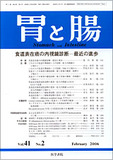Japanese
English
- 有料閲覧
- Abstract 文献概要
- 1ページ目 Look Inside
- 参考文献 Reference
- サイト内被引用 Cited by
要旨 近年,内視鏡画像が高画質化し食道の微細な変化を認識しやすくなった.しかし,通常内視鏡だけで食道表在癌を確定診断することは難しく,従来はヨード染色や生検による補助診断が必須であった.ヨード染色は被検者に不快感を強いて,病変にもダメージを与える.生検は病変を分断し,粘膜下層の線維化を来すためESDの妨げになることもある.一方,拡大内視鏡を用いると食道表面の微細な血管模様を観察することができ,その血管パターンから腫瘍・非腫瘍の鑑別が可能である.また,拡大内視鏡は被験者や病変にダメージを与えることがない.本稿では自験例を示し,拡大所見が食道表在癌の拾い上げ診断に有用であることを示した.
Iodine staining is an effective screening method for finding superficial esophageal squamous cell carcinoma (SCC). However, adverse effects such as heartburn or nausea sometimes occur after iodine staining. Recently, the characteristic vascular pattern of superficial cancer has become clear, so magnified endoscopy is able to observe the vascular pattern in vivo.
Until recently, iodine staining was recommended for diagnosis of SCC, when a slightly red part or a shallow depressed part was observed. However, magnified endoscopy is able to observe the fine vascular pattern that leads to a diagnosis of SCC without having to resort to iodine staining. The narrow banding image (NBI) system can be used to assist in magnified endoscopy, but the NBI is not necessary for the observation of the vascular pattern by magnified endoscopy.
The presented cases in this paper showed the effectiveness of magnified endoscopy for the screening of superficial esophageal SCC.

Copyright © 2006, Igaku-Shoin Ltd. All rights reserved.


